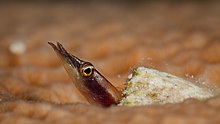| Lucayablennius zingaro | |
|---|---|

| |
| Conservation status | |
 Least Concern (IUCN 3.1) | |
| Scientific classification | |
| Domain: | Eukaryota |
| Kingdom: | Animalia |
| Phylum: | Chordata |
| Class: | Actinopterygii |
| Order: | Blenniiformes |
| Family: | Chaenopsidae |
| Genus: | Lucayablennius Böhlke, 1958 |
| Species: | L. zingaro |
| Binomial name | |
| Lucayablennius zingaro (Böhlke, 1957) | |
| Synonyms | |
|
Lucaya zingaro Böhlke, 1957 | |
Lucayablennius zingaro, the arrow blenny, is a species of chaenopsid blenny found in coral reefs around the Bahamas and the Caribbean, in the western central Atlantic Ocean. It can reach a maximum length of 5.7 cm (2.2 in). This species is the only known member of its genus.
Habitat
The arrow blenny can be found in costal coral reefs near the Bahamas, Caribbean, and western Atlantic Ocean. Their range extends as far west as the western side of the Yucatán Peninsula, as far north as the Florida Keys, and as far south as the eastern tip of South America. Their depth range is typically 13 to 106 meters (42.6 to 347.7 ft).
Description
The arrow blenny is truly unique among blennys regarding their appearance. They have an elongated pointed snout which they use for catching prey. Their coloration is typically a cinnamon red or brown which fades to yellow towards the tail. They have three stripes, one white one on the top center of the head ending at the base of the dorsal fin, and one on each side starting at the front of the eyes and running to the base of the caudal fin. Both of these side stripes start white and fade to yellow. They also have black spots, three on the rear of the dorsal fin and two on the rear of the anal fin. Their tail, being truly unique, is always held at a curve. So much so that the tail is facing the same direction as the head. This tail curve allows the fish to catch small currents in the water column.
References
- Böhlke, J. E. 1957 (26 July) A review of the blenny genus Chaenopsis, and the description of a related new genus from the Bahamas. Proceedings of the Academy of Natural Sciences of Philadelphia v. 109: 81-103, Pls. 5-6.
- Böhlke, J. E. 1958 (21 Feb.) Substitute names for Nystactes Böhlke and Lucaya Böhlke, preoccupied. Copeia 1958 (no. 1): 59.
- Williams, J.T. (2014). "Lucayablennius zingaro". IUCN Red List of Threatened Species. 2014: e.T47143309A48403427. doi:10.2305/IUCN.UK.2014-3.RLTS.T47143309A48403427.en. Retrieved 20 November 2021.
- Froese, Rainer; Pauly, Daniel (eds.). "Lucayablennius zingaro". FishBase. February 2013 version.
- "Lucayablennius zingaro, Arrow blenny". www.fishbase.se. Retrieved 2024-03-10.
- "Shorefishes - The Fishes - Species". biogeodb.stri.si.edu. Retrieved 2024-03-10.
- "Lucayablennius zingaro, Arrow blenny". www.fishbase.se. Retrieved 2024-03-10.
External links
- Photos of Lucayablennius zingaro on Sealife Collection
| Taxon identifiers | |
|---|---|
| Lucayablennius zingaro | |
This Chaenopsidae article is a stub. You can help Misplaced Pages by expanding it. |